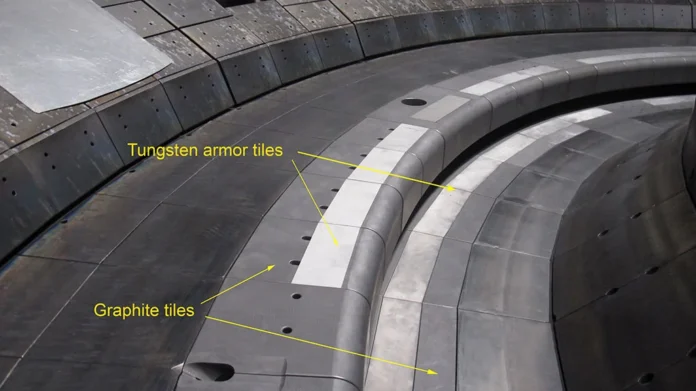San Diego. Scientists at the DIII-D National Fusion Facility (DIII-D) have found the mechanism responsible for enhanced erosion of the inner walls of fusion tokamaks, potentially solving a significant challenge to the viability of future fusion reactors. The results, described in an article published in the journal Physics of Plasmas, may provide a pathway for substantially reducing erosion in the ITER experiment under construction in France, as well as future commercial power plants.
DIII-D is the largest magnetic fusion research facility in the US and is operated by General Atomics (GA) as a national user facility for the US Department of Energy Office of Science. The heart of the facility is a tokamak that uses powerful electromagnets to produce a doughnut-shaped magnetic bottle for confining a fusion plasma. Plasma is the fourth state of matter in which electrons are stripped from the atoms, producing a highly ionized “soup” of nuclei and electrons that can be controlled by magnetic fields. In DIII-D, plasma temperatures more than 10 times hotter than the Sun are routinely achieved. At such extremely high temperatures, hydrogen isotopes can fuse together and release energy. (See Fusion Energy 101 explainer below for more detail on how fusion works.)
However, plasma particles and their associated heat eventually leak through the tokamak’s magnetic fields. For this reason, tokamaks incorporate a device called a divertor that removes stray particles and heat from the edge regions of the plasma. Because fusion plasmas are so hot and energetic, these particles can erode the tungsten armor of the divertor after they pass through the divertor plasma.
This erosion is particularly severe during plasma ejection events known as “Edge-localized Modes” (ELMs). ELMs cause bursts of heat from the plasma containing large quantities of high-energy particles, much like solar flares eject energetic particles from the sun. Because ELMs occur during operational conditions similar to those that will be used in future fusion power plants, finding methods to control erosion caused by ELMs is critical in making fusion energy a practical reality.
“We’ve known for many years that ELMs need to be controlled, because they cause fusion power to drop significantly,” said Tyler Abrams, the plasma physicist at GA who led the team that made the discovery. “What hasn’t been clear is exactly how tight these controls need to be to reduce erosion of the wall armor to acceptable levels. That matters because ELM control methods dictate the operational conditions we need for future commercial fusion power plants to be viable. We need efficient methods to control both the heat pulses and wall armor erosion.”
Recently, the GA-led team pinpointed the mechanism that governs erosion by comparing experimental data on DIII-D with modeling predictions, which suggested energetic ions released during ELMs are the dominant source of erosion. Agreement with experimental results was remarkable when these particles were included in the model, while significantly less erosion was predicted when these particles were not included. Further confirmation came from observations that a decrease in ELM intensity was accompanied by a commensurate decrease in erosion damage.
The team also conducted new simulations extrapolating the results to the much larger and more powerful ITER device. This modeling also showed that nearly all damage to ITER’s wall armor will be caused by energetic hydrogen fuel ions ejected during ELMs rather than less energetic impurity ions.
The DIII-D research program is at the forefront of research aimed at reducing the impact of ELMs, and another DIII-D team received the American Physical Society’s 2018 Excellence in Plasma Physics award for work in this area. The results described in the current paper provide further evidence that these ELM-control techniques will be very beneficial in reducing material erosion in future fusion reactors, thereby improving their viability and performance.





